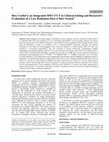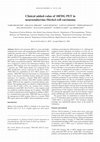Papers by Tarik-Zine Belhocine

In nuclear medicine, [ 18 F]-fluorodeoxyglucose positron emission tomography ( 18 FDG PET) and ly... more In nuclear medicine, [ 18 F]-fluorodeoxyglucose positron emission tomography ( 18 FDG PET) and lymphatic mapping and sentinel lymphadenectomy (LM/SL) may significantly improve the staging of primary cervical cancers. Indeed, the disease progresses in a 'level by level' fashion to regional nodes through the lymphatic channels, and also to extra-nodal sites via the hematogenous stream. Additionally, the sub-optimal efficacy of routine radiological protocols, while new combined therapies are proving to be more efficient, stresses the need for alternative staging procedures. Current data suggest that LM/SL accurately reflects the regional lymph node status in early stage cervical cancers, and thus could avoid unnecessary complete lymphadenectomies. Also, whole body 18 FDG PET may provide valuable insights on extra-pelvic and distant tumor spreading, with a significant impact on treatment choices. If these promising results are confirmed on large controlled trials, LM/SL and 18 FDG PET imaging could be incorporated in the routine staging work-up of primary cervical cancers. #

Apoptosis or genetically programmed cell death is a universal phenomenon involving many pathophys... more Apoptosis or genetically programmed cell death is a universal phenomenon involving many pathophysiological conditions. Externalization of phosphatidylserine from the inner leaflet to the outer leaflet of the cell membrane is an early event in the apoptotic cascade occurring before membrane blebbing and DNA fragmentation. Annexin A5, a 36 kDa endogenous protein, specifically binds to phosphatidylserine with a nanomolar affinity in presence of calcium ions. In molecular imaging, phosphatidylserine has been used as a molecular target for the imaging of apoptosis with 99mTc-annexin A5 as a molecular probe. In clinical research, recombinant human 99mTc-annexin A5 has been successfully used in phase I, II, III and IV trials for the non-invasive assessment of apoptotic reserve in vivo. In academic centers, annexin A5 imaging has also been the subject of theses including doctoral theses, master theses and mémoire. This review highlights the large body corpus of literature on the radiolabeled annexin A5 imaging including publications on clinical trials and academic dissertations.

Lymphatic mapping and sentinel lymphadenectomy (LM/SL) have been successfully used in pre-treatme... more Lymphatic mapping and sentinel lymphadenectomy (LM/SL) have been successfully used in pre-treatment nodal staging of gynaecological cancers. We hypothesised the added-value of LM/SL plus SPECT/CT in patients with early stage of cervical cancer and vulvar cancer. A prospective, single-center, diagnostic, open label, active control, non-randomized clinical trial has been conducted in 7 patients with FIGO IA-IB1 cervical cancer and 7 patients with FIGO stage I-II-IIIcN0 vulvar cancer. All patients underwent LM/SL plus SPECT/low-dose CT and complete lymph node dissection (CLND) according to the standard of care. In case of negative hematoxylin-eosin staining, serial sections of the SLNs were analysed by immunohistochemistry and high molecular weight cytokeratin. Primary outcome measures were the detection rate, the sensitivity (SV), the negative predictive value (NPV), the diagnostic accuracy (DA) for anatomic localisation of SLNs, and the impact on management of SPECT/CT guided LM/SL versus CLND. The secondary outcome measure was the patient tolerability and operating time of LM/SL guided SPECT/CT versus CLND. http://clinicaltrials.gov/show/NCT00773071 All 14 patients were enrolled into the 1-day research protocol
with dual-tracer LM/SL and SPECT/CT. Additional SLNs were detected on SPECT/CT compared to conventional planar imaging. Hot and cold > 1cm SLNs were detected on SPECT/CT. Detection rate, SV, NPV, DA were 100% in both groups; false negative rate was 0%. Rate of SLN metastases was 28.5% in cervical cancer and 42.9% in vulvar cancer. Impact on treatment was 28.5% and 14.3% in cervical cancer and vulvar cancer patients, respectively. SPECT/CT was well tolerated by all patients and operating time for LM/SL was within 30 min. No adverse events were reported with a time frame of 1-to-3 years. In early stage of gynaecological cancers, SPECT/low-dose CT is technically feasible and of clinical added-value for LM/SL.
Prostate Cancer and Prostatic Diseases, 2012
Clinical Nuclear Medicine, 2011
Chronic excess tearing or epiphora is seen in differentiated thyroid cancer patients who have rec... more Chronic excess tearing or epiphora is seen in differentiated thyroid cancer patients who have received multiple doses of I-131 therapy. A 25-year-old woman with a papillary thyroid cancer received 6 doses of I-131 (Ϯ37GBq) for I-131-avid lung metastases. The patient underwent a diagnostic I-131 whole-body scan plus SPECT/CT for a borderline thyroglobulin. I-131 whole-body scan demonstrated a right periorbital focus as shown in , which was precisely localized on SPECT/CT at the right proximal nasolacrimal duct as shown in . Dacryoscintigraphy documented a right high-grade obstruction as shown in . The patient underwent a right dacryocystorhinostomy with a Crawford tube insertion. SPECT/CT allows anatofunctional definition of pathophysiological I-131 uptake patterns.
Clinical Nuclear Medicine, 2000
... diseases, and the initial staging, restaging, therapy planning, and monitoring response of lu... more ... diseases, and the initial staging, restaging, therapy planning, and monitoring response of lung cancer Mavi, A; Lakhani, P; Zhuang, HM ... Positron emission tomography imaging in nonmalignant thoracic disorders Alavi, A; Gupta, N; Alberini, JL; Hickeson, M; Adam, LE; Bhargava ...
European Journal of Nuclear Medicine and Molecular Imaging, 2004
Dear Sir, I read with great interest the data reported by S.M. Wiener and colleagues regarding th... more Dear Sir, I read with great interest the data reported by S.M. Wiener and colleagues regarding the role of 18 FDG PET in detecting brain abnormalities associated with Takayasu's arteritis (TA) . I thank the authors for providing new information about the added value of 18 FDG PET in the investigation of TA. Their report highlighted the ability of PET to detect metabolic impairments in five patients with TA at the level of both the whole body (3/5) and the brain (4/5). These findings complement the data recently published in the EJNM [2] and extend the debate.

The Open Medical Imaging Journal, 2008
Hybrid imaging is becoming a popular technology in nuclear medicine. We have evaluated the added ... more Hybrid imaging is becoming a popular technology in nuclear medicine. We have evaluated the added value of an integrated SPECT/low-dose multislice CT over conventional planar/SPECT nuclear imaging. Phantom and clinical studies were performed on the Infinia™ Hawkeye™ 4 slice (HWK-4) with an upgraded software package (Xeleris 2.05v) from GE Heatlthcare to assess 1) the benefit of CT for contrast-resolution, attenuation correction, and anatomic localisation; 2) the impact of hybrid imaging in 456 consecutive patients in a clinical setting. SPECT/CT data were compared to conventional planar/SPECT data and correlated to clinical, biochemical, morphological imaging, angiography, and pathology findings. SPECT/CT was well tolerated by the patients with minimal CT irradiation dose (< 2mSv). HWK-4 provided useful attenuation correction for its routine use in MPI and accurate anatomic localisation of physiological and pathological foci in 99m Tc-RBC, 99m Tc-HMPAO-WBC, 131/123 I-MIBG, Octreoscan ® , and 67 Ga studies. Low-dose multislice CT also helped detect gross morphological abnormalities. Hybrid imaging had a significant impact in ProstaScint ® and parathyroid imaging for image-guided intervention. In bone imaging and differentiated thyroid cancers, SPECT/CT was able to clarify equivocal findings from planar whole-body scan. SPECT/CT was also found useful to precisely localize sentinel lymph nodes. Research protocols are being evaluated for half-time acquisition with resolution recovery and quantification of tracer distribution. SPECT/low-dose multislice CT has been successfully implemented in routine clinical practice. CT provided added value for effective attenuation correction and accurate anatomic localisation of disease with an impact on patient management. Keywords: Hybrid imaging, SPECT/CT, low-dose multislice CT, clinical impact. § Part of this work was presented as selected poster at the Lawson Research Day (London, Canada, March 2007).
Clinical Nuclear Medicine, 2001

European Journal of Nuclear Medicine and Molecular Imaging, 2003
Fluorine-18 fluorodeoxyglucose positron emission tomography ( 18 FDG PET) plays a major role in t... more Fluorine-18 fluorodeoxyglucose positron emission tomography ( 18 FDG PET) plays a major role in the management of oncology patients. Owing to the singular properties of the glucose tracer, many patients suffering from non-malignant diseases such as inflammatory or infectious diseases may also derive clinical benefit from the appropriate use of metabolic imaging. Large vessel vasculitides such as giant cell arteritis and Takayasu arteritis are other examples that may potentially extend the field of 18 FDG PET indications. The purpose of the present article is to assess the feasibility of metabolic imaging in vasculitis on the basis of the current literature data. In particular, the clinical context and the 18 FDG imaging patterns seen in patients with large vessel vasculitis are analysed in order to identify potential indications for metabolic imaging.

Chemosensitivity, 2005
Accurate and early evaluation of tumor response to chemotherapy is a growing clinical need for op... more Accurate and early evaluation of tumor response to chemotherapy is a growing clinical need for optimal management of oncology patients. This is even more warranted by the lack of appropriate response evaluation criteria to new molecularly targeted anticancer therapies. In the two last decades, new developments in the field of nuclear oncology have allowed the introduction of various radiopharmaceuticals to be used on dedicated imaging devices. In the present chapter, we report the added value that positron emission tomography (PET) with 18 F-fluorodeoxyglucose ( 18 FDG) may offer to assess tumor response to treatment. PET is a high-end imaging technology using 18FDG as metabolic tracer that mimics the biochemical behavior of the natural glucose molecule. Because most tumor types exhibit increased glucose metabolism, the imaging of 18 FDG uptake within cancer tissues prior to any treatment enables the metabolic technique to follow tumor responsiveness sequentially after one or several courses of chemotherapy. Moreover, metabolic tumor response evaluated by 18 FDG PET often precedes morphological tumor changes measured by computed tomography or magnetic resonance imaging. So far, the suboptimal properties of 18 FDG tracer and the lack of standardized methodology in PET imaging remain objective limitations for qualitative and quantitative assessment of chemosensitivity using the metabolic method.
European Journal of Nuclear Medicine and Molecular Imaging, 2005
European Journal of Nuclear Medicine and Molecular Imaging, 2007

Chemosensitivity, 2005
Most anticancer agents act by inducing apoptosis in sensitive tumor cells. Hence, in many types o... more Most anticancer agents act by inducing apoptosis in sensitive tumor cells. Hence, in many types of cancers, significant increase of tumor apoptosis after chemotherapy correlates with tumor chemosensitivity. Theoretically, a reliable evaluation of apoptotic changes, postchemotherapy to baseline, may provide valuable insights into the apoptotic competence of cancers. Until now, assessment of chemosensitivity has usually relied upon histological evidence of tumor response (i.e., partial or complete disappearance of tumor cells) or demonstration of tumor shrinkage by means of morphological imaging (i.e., computed tomography or magnetic resonance imaging). In clinical practice, however, these conventional methods are proving ineffective for monitoring tumor chemosensitivity on a daily basis. Recent developments in molecular imaging have allowed the synthesis of a new radiolabeled agent, 99m Tc-recombinant human Annexin A5, designed to the assessment of apoptotic response of cancers after a single course of chemotherapy. Such in vivo technique opens promising perspectives for evaluating, noninvasively and early, tumor response to anticancer therapies. Alternative methods for Annexin A5 labeling and imaging may improve the detection of drug-induced apoptosis to monitor chemosensitivity.
EJNMMI Research, 2011
Nuclear medicine has become a key part of molecular imaging. In the present review article, we fo... more Nuclear medicine has become a key part of molecular imaging. In the present review article, we focus on the transbilayer phospholipids as exquisite targets for radiolabelled probes in molecular imaging. Asymmetry of phospholipid distribution is a characteristic of mammalian cell membranes. Phosphatidylcholine and sphyngomyelin cholinophospholipids are primarily located within the external leaflet of the cell membrane. Phosphatidylserine and phosphatidylethanolamine aminophospholipids, and also phosphatidylinositol are primarily located within the internal leaflet of the cell membrane. New radiolabelled tracers have been designed in preclinical and clinical research for PET-CT and SPECT-CT molecular imaging of transbilayer phospholipids.
Journal of Proteome Research, 2004
In the past decade, genomics and proteomics have begun to develop many new targets for potential ... more In the past decade, genomics and proteomics have begun to develop many new targets for potential diagnostic and therapeutic agents. Among the life sciences, nuclear medicine is also deeply involved in the field of clinical investigation. Experience with radiolabeled annexin V highlights the many steps required to translate a good basic-science concept into the clinical setting. This model also emphasizes the value of synergy between basic and medical specialties in developing and optimizing a clinically useful product initially derived from basic investigation.
Gynecologic Oncology, 2002
Objective. The objective of this study was to assess the contribution of [ 18 F]fluoro-2-deoxy-D-... more Objective. The objective of this study was to assess the contribution of [ 18 F]fluoro-2-deoxy-D-glucose positron emission tomography ( 18 FDG PET) imaging in the management of cervical cancer.

Oncology Reports, 2006
Merkel cell carcinoma (MCC) is a rare and highly malignant skin cancer with neuroendocrine differ... more Merkel cell carcinoma (MCC) is a rare and highly malignant skin cancer with neuroendocrine differentiation. We studied the potential value of 18 FDG PET in the management of MCC. Eleven patients with MCC were examined by 18 FDG PET and PET-CT for staging purpose (n=4) or for detection of recurrence (n=7). Qualitative and quantitative interpretation of PET studies was performed routinely. 18 FDG PET observations were compared to clinical and radiological findings. In 6 patients, PET findings were also compared to histology. In 7 patients, the 18 FDG tumor uptake was compared to the MCC proliferative activity expressed by the Ki-67 index. 18 FDG PET was contributive in 10/11 MCC patients. In 7 patients, 18 FDG PET detected focal lesions or a disseminated stage of the disease including dermal, nodal and visceral metastases. In 3 patients, a normal 18 FDG PET confirmed complete remission of disease. Most MCC patients exhibited highly 18 FDG-avid sites suggestive of increased glucose metabolism. This imaging pattern was related to a high proliferative activity (Ki-67 index >50%). In 1 patient with a weakly proliferative nodal MCC (Ki-67<10%), a false negative result was yielded by metabolic imaging. In 4/11 patients, 18 FDG PET revealed an unsuspected second neoplasm in addition to MCC. It is concluded that whole-body 18 FDG PET may be useful in the management of MCC patients. However, a normal 18 FDG PET aspect cannot rule out MCC with low proliferative activity.
Gynecological Surgery, 2004
Whole-body 18 FDG PET plus pelvic MRI in the pre-treatment assessment of cervical cancers: an alt... more Whole-body 18 FDG PET plus pelvic MRI in the pre-treatment assessment of cervical cancers: an alternative to the FIGO clinical staging Authors: Belhocine I. Permission to publish Dear Anneliese Sand, I have checked the proofs of my article and ❑ I have no corrections. The article is ready to be published without changes. ❑ I have a few corrections. I am enclosing the following pages: ❑ I have made many corrections. Enclosed is the complete article. II. Offprint order ❑ I do not wish to order offprints ❑ Offprint order enclosed Remarks: Date / signature




Uploads
Papers by Tarik-Zine Belhocine
with dual-tracer LM/SL and SPECT/CT. Additional SLNs were detected on SPECT/CT compared to conventional planar imaging. Hot and cold > 1cm SLNs were detected on SPECT/CT. Detection rate, SV, NPV, DA were 100% in both groups; false negative rate was 0%. Rate of SLN metastases was 28.5% in cervical cancer and 42.9% in vulvar cancer. Impact on treatment was 28.5% and 14.3% in cervical cancer and vulvar cancer patients, respectively. SPECT/CT was well tolerated by all patients and operating time for LM/SL was within 30 min. No adverse events were reported with a time frame of 1-to-3 years. In early stage of gynaecological cancers, SPECT/low-dose CT is technically feasible and of clinical added-value for LM/SL.
with dual-tracer LM/SL and SPECT/CT. Additional SLNs were detected on SPECT/CT compared to conventional planar imaging. Hot and cold > 1cm SLNs were detected on SPECT/CT. Detection rate, SV, NPV, DA were 100% in both groups; false negative rate was 0%. Rate of SLN metastases was 28.5% in cervical cancer and 42.9% in vulvar cancer. Impact on treatment was 28.5% and 14.3% in cervical cancer and vulvar cancer patients, respectively. SPECT/CT was well tolerated by all patients and operating time for LM/SL was within 30 min. No adverse events were reported with a time frame of 1-to-3 years. In early stage of gynaecological cancers, SPECT/low-dose CT is technically feasible and of clinical added-value for LM/SL.